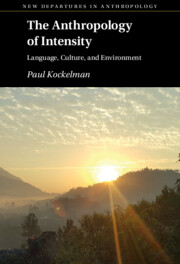Book contents
- The Anthropology of Intensity
- New Departures in Anthropology
- The Anthropology of Intensity
- Copyright page
- Dedication
- Contents
- Figures
- Tables
- Acknowledgments
- Abbreviations
- Introduction: Intensity
- Part I Grounds
- Part II Tensors
- Part III Thresholds
- Nine Temporality and Replacement
- Ten Temporal Thresholds
- Eleven Modality and Worlding
- Twelve Modal Thresholds
- Conclusion: The Ecological Self
- References
- Index
Twelve - Modal Thresholds
from Part III - Thresholds
Published online by Cambridge University Press: 05 May 2022
- The Anthropology of Intensity
- New Departures in Anthropology
- The Anthropology of Intensity
- Copyright page
- Dedication
- Contents
- Figures
- Tables
- Acknowledgments
- Abbreviations
- Introduction: Intensity
- Part I Grounds
- Part II Tensors
- Part III Thresholds
- Nine Temporality and Replacement
- Ten Temporal Thresholds
- Eleven Modality and Worlding
- Twelve Modal Thresholds
- Conclusion: The Ecological Self
- References
- Index
Summary
Chapter 12 focuses on modal intensifiers in Q’eqchi’-Maya – the forms tz’aqal and num(tajenaq), which are similar in function to English ‘enough’ and ‘too’, respectively. In particular, one of the functions of such forms is to indicate that the degree of some dimension is above or beyond an acceptable range, such that a key condition for an action or event is, or is not, met. These last two forms are particularly important because they link together significant degrees of salient dimensions, and hence intensity, and relate it to acceptability, and hence modality. Such forms are particularly salient in the context of an institution like replacement because speakers routinely use them, in conjunction with the temporal operators discussed in chapter 9, to represent and regiment various possibilities. For example, at what age does a boy acquire the requisite competence (strength and skill) to an adequate degree, such that it is normatively permissible that he may stand in for, or replace, his father in a labor pool.
- Type
- Chapter
- Information
- The Anthropology of IntensityLanguage, Culture, and Environment, pp. 327 - 355Publisher: Cambridge University PressPrint publication year: 2022

